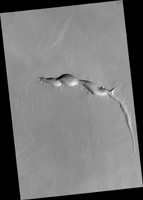
Map Projected Browse Image
Click on image for larger versionGordii Fossae is a volcanic region near Olympus Mons, the planet's largest volcano.
The smooth volcanic surfaces in the Gordii Fossae region are sometimes interrupted by long, narrow troughs, or fissures. These fissures form when underground faults, possibly involving magma movement, reach the near-surface, allowing material to collapse into pits or an elongated trough. This fissure appears to have erupted material that flowed onto the surface.
If you use your imagination, this trough resembles a gecko with its long tail and web-shaped feet!
The map is projected here at a scale of 25 centimeters (9.8 inches) per pixel. (The original image scale is 29.5 centimeters [11.6 inches] per pixel [with 1 x 1 binning]; objects on the order of 88 centimeters [34.6 inches] across are resolved.) North is up.
This is a stereo pair with ESP_070333_1970.
The University of Arizona, in Tucson, operates HiRISE, which was built by Ball Aerospace & Technologies Corp., in Boulder, Colorado. NASA's Jet Propulsion Laboratory, a division of Caltech in Pasadena, California, manages the Mars Reconnaissance Orbiter Project for NASA's Science Mission Directorate, Washington.

